
Important:
Before you read this section on advanced concepts, please first read the section explaining the basics of the circle system by clicking here.
The circle breathing system is involved with the flow of gases. From a physics point of view, gases are considered to be “fluids” and unfortunately, the physics of fluids is extremely complicated ( mostly beyond what my brain cells can cope with).

However, there are some important concepts concerning circle systems that one needs to understand to use it correctly. In this section, I will try and introduce you to some of these concepts (i.e.).
- Problem of Rise Time
- How low can we go with the fresh gas flow ?
- Washing out of anaesthetic agent
I have found it quite challenging to explain the concepts. If you cannot follow my explanations, please do not persists, because most likely, I have not explained it properly! After you finish, I would be really grateful if you will give me feedback by clicking the feedback button on the menu at the top. Thank you and good luck !
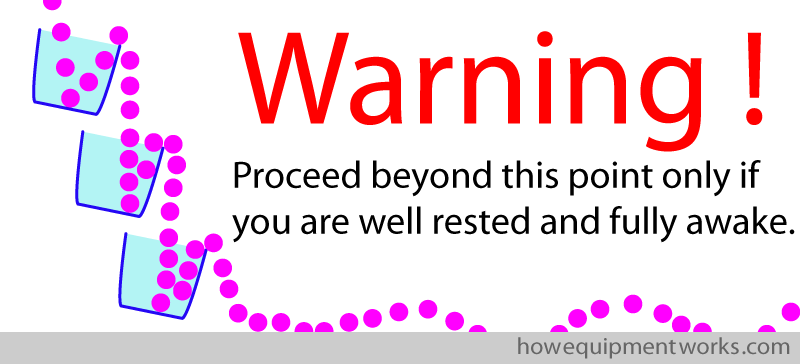
The problem of the “Rise Time (delay)”
During all times, you will want to control the concentration of the anaesthetic agent being inspired by your patient. However, it is very important to remember that with circle systems, there is a time delay between setting a concentration on the vaporiser (red arrow) and the patient inspiring the concentration you set (green arrow).

This response delay is NOT only due to the time it takes anaesthetic gases to travel from the red arrow to the green arrow ! The reasons are a little bit more complicated, but do not worry, I will explain the reasons to you in the next sections.

I will now explain the concept of what I call, circle system “rise time”, to you. Let us imagine that we have a new imaginary anaesthetic agent called “Prasflurane” ( the first four letters are from my own name, Pras !). Below is an imaginary vaporiser that can deliver Prasflurane and you have turned the dial on it to two percent.

Imagine that the Prasflurane vaporiser is connected to the circle system and as mentioned before, you have set the dial to two percent ( pink line below shows vaporiser setting). The anaesthesia ( and surgery !) has been proceeding uneventfully for some time and the patient is inspiring a Prasflurane concentration of 2 % ( blue line).

Let us now imagine that the surgeon does something that is very stimulating to the patient. This makes our patient move and therefore, to deepen the anaesthetic, you immediately turn the Prasflurane vaporiser from 2 % to 4 % (red arrow). However, our patient continues to move ! This is because, with the circle system, there is a time delay between when you set the vaporiser concentration ( red arrow) and the patient inspiring that concentration (green arrow). I would like to call this delay the “rise time” ( time taken for the concentration to “rise” to the required level).
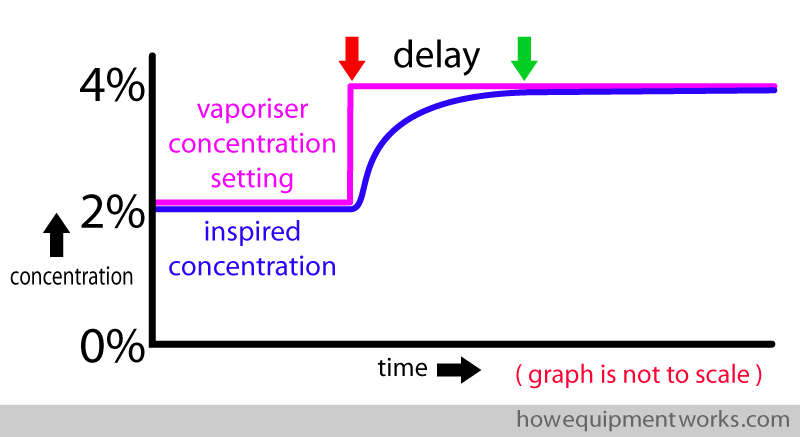
I will explain to you why circle systems can have a slow rise time. Understanding the reasons will help you to use methods that can reduce this rise time. To understand the issue of rise time, I will first have to introduce you to the various concepts shown below. Do not worry ! I will explain, one by one, each of the points to you.

Fresh gas flow through vaporiser :

Let us start our discussion with the concept of ” fresh gas flow through vaporiser”.
You will know from our previous discussions, that we need to give fresh gas flow to the circle system. This fresh gas flow goes through the vaporiser. The vaporiser “adds “ anaesthetic agent to the fresh gas flow that goes through it.

I would like to now use simpler diagrams to explain things. First, let us think about what “flow “ means. Flow is the movement of a volume of substance over a period of time (e.g. mL / minute). For the purpose of this discussion, I would like you to imagine that the fresh gas comes out of the flow meters in little cups ! Let us imagine that each cup has a volume of 100 mL. So in the example below, the fresh gas flow is 400 mL / minute.

Similarly, the example below shows a fresh gas flow of 800 mL / minute.

As mentioned before, the fresh gas flow goes through a vaporiser. In the example below, the fresh gas flow cups are going through the Prasflurane vaporiser, which is adding anaesthetic agent.

Since all the fresh gas flow from the flow meters goes through the vaporiser, I will from now on name “fresh gas flow “ as “fresh gas flow through vaporiser”.

Vaporiser output concentration :
Let us now understand the concept of “vaporiser output concentration “.
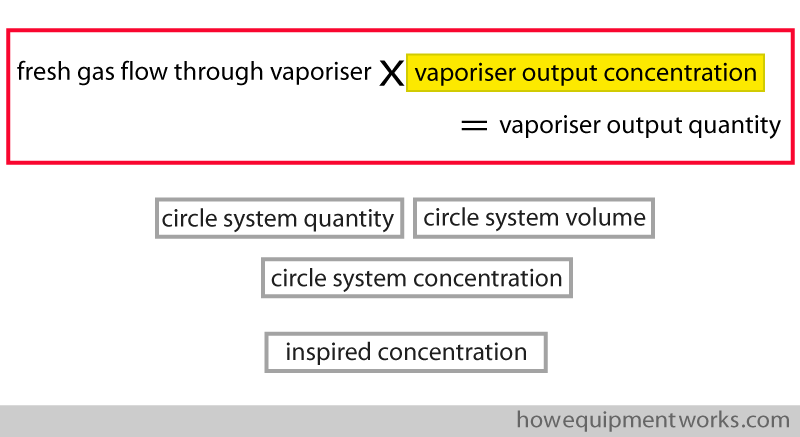
The “vaporiser output concentration” is the “concentration” that you set on your vaporiser. The fresh gas flow coming out of your vaporiser ( i.e. vaporiser output) will have the concentration you set.

So what is concentration ? Concentration is “amount of a substance in a unit volume”. In our example, we will make the “unit volume” a 100 mL cup. Below are two “Prasflurane” vaporisers. In the upper vaporiser, you have set the vaporiser output concentration to ” 1 molecule / cup “ and therefore the vaporiser puts one molecule into each 100 mL cup. In the lower vaporiser, you have set the vaporiser output concentration to ” 2 molecules / cup “, and it therefore puts two molecules into each cup.

Vaporiser output quantity :
The “vaporiser output quantity” is the total quantity of substance that comes out of the vaporiser in a given time. As will be explained, it depends on the fresh gas flow through the vaporiser and the vaporiser output concentration.

Look at the example below. The fresh gas flow through the vaporiser is two cups per minute. The vaporiser output concentration has been set by you to ” 2 molecules per cup “. The vaporiser output quantity in a minute is therefore ” 4 molecules “. You can see that the vaporiser output quantity is determined by both : the fresh gas flow through the vaporiser and the vaporiser output concentration.

Here is another example. This time the vaporiser output quantity is 12 molecules.
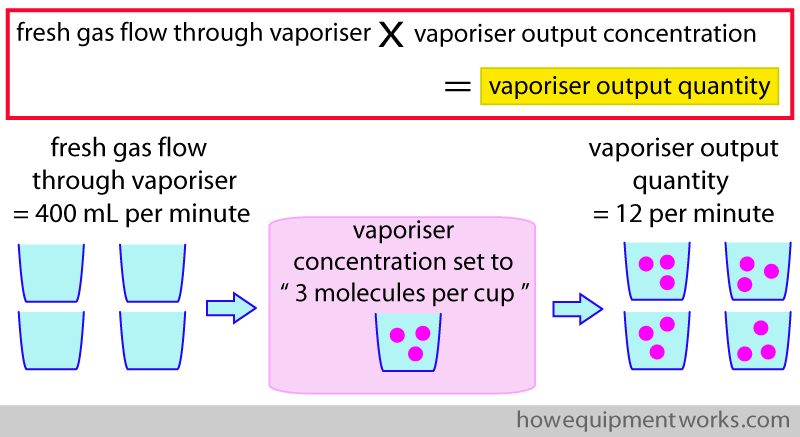
Please note that “vaporiser output quantity” is not the same as “vaporiser output concentration”.

The concept of vaporiser output quantity is very important and we will return to it later in our discussion. Let us now now look at the remaining concepts.
Circle system volume:
We will now look at the issue of circle system volume.

As you know, the circle system has long tubing, a reservoir bag, and the CO2 absorber. All these parts have volumes that add up to make up the “circle system” volume. As will be explained later, this “volume” is the main reason as to why circle systems have a slow rise time.

To make things easier to understand, I will from now on, represent the circle system volume as a large container.

Circle system quantity :
Next we will talk about what I mean by “circle system quantity”.

At any given time, the circle system will have a quantity of anaesthetic agent in it. I would like to call this quantity as “circle system quantity “. In this example, the circle system quantity is 6 molecules.

And in this case, the circle system quantity is 12.

Circle system concentration :
The quantity of anaesthetic agent in a circle system ( circle system quantity) is distributed throughout its volume. The “circle system concentration” tells you , how “tightly” packed the anaesthetic agent quantity is, in the circle system volume.

You will recall that, when we talked about vaporiser output concentration, we said that “concentration” is “amount of a substance in a unit volume”. We chose the “unit volume” to be a 100 mL cup.

We can also use a 100 mL cup to describe the circle system concentration. Here is how ! We lower an imaginary cup into the circle system volume and see how many molecules spread into the cup. We can then express the concentration like we did for the vaporiser. In the example below, we have a circle system quantity of 8 molecules spread out in the circle system volume. Dipping our 100 mL cup into the circle system volume shows us that the circle system concentration is 2 molecules per 100 mL. Please do not over analyse this description of cups etc as they are there only to give you a rough idea of what is going on.

Let us double the circle system quantity and see what happens to the circle system concentration.

You see that increasing the circle system quantity increases the circle system concentration.

Inspired concentration :
We are finally near the end of the list of things we need to understand before we talk about circle system rise times. The final thing to understand is the concentration of anaesthetic inspired by the patient.

We ultimately want the anaesthetic agent to be inspired by the patient. The patient inspires from the circle system and therefore the inspired concentration of anaesthetic agent is essentially the same as the circle system concentration.
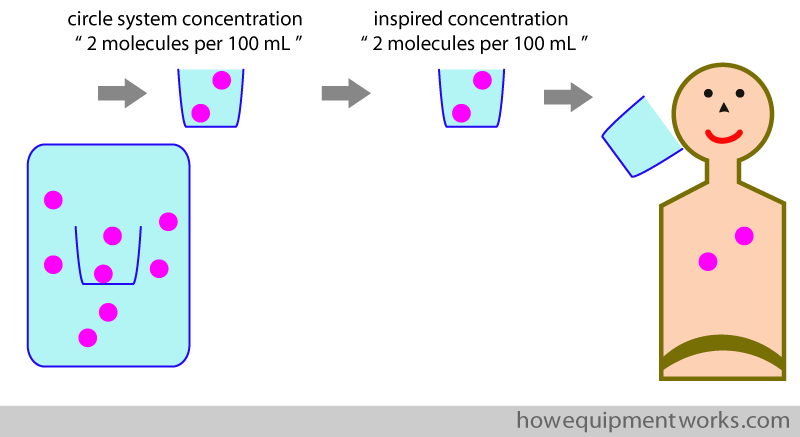
The higher the circle system concentration, the higher will be the inspired concentration.

Reason for slow rise time:
We are now ready to discuss the issue about circle system rise time. In an ideal world, when you change the vaporiser output concentration, you want the patient to instantly inspire the concentration that you set.

In reality, when using circle systems, there is a delay between when you set the vaporiser output concentration and the patient inspiring the concentration you set. I like to call this delay the “rise time” ( i.e. the time it takes the inspired concentration to match the set vaporiser output concentration.

Let us now imagine that we want to rapidly deepen the level of anaesthesia in our patient. i.e. we want to rapidly increase the inspired concentration.

To increase the inspired concentration, we need to increase the circle system concentration. How do we do that ? In the next few images, I will explain how, using the concepts we have learnt so far.

The first thing we do is to provide a vaporiser output quantity. We set a vaporiser output concentration on the vaporiser. We also give fresh gas flow through the vaporiser. The result is that there is a vaporiser output quantity.
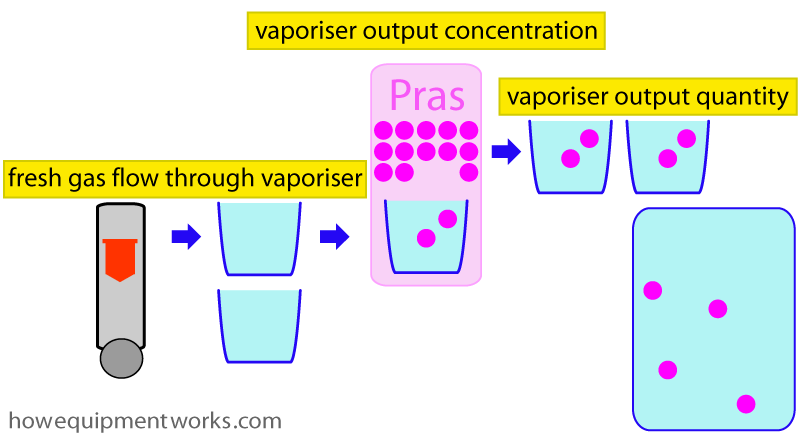
Now we have two quantities: the vaporiser output quantity and the circle system quantity.

The vaporiser output quantity gets added to the existing circle system quantity. This increases the circle system quantity.

The increased circle system quantity increases the circle system concentration (since there are more “molecules” packed in the same circle system volume).

The patient then inspires this increased concentration.

Now the question we can finally ask is, why is there a slow rise ? Let us again imagine that we want to rapidly increase the circle system concentration.

We set the flow meter to give 1 cup per minute and set the vaporiser output concentration to 1.


You can see that at the low fresh gas flow of ” 1 cup per minute ” and vaporiser output concentration set at ” 1 molecule per cup “, the vaporiser output quantity is only 1 molecule per minute.
At such a low vaporiser output quantity ( 1 molecule per minute), it will take a very long time for the circle system volume ( which is quite large) to get filled up with molecules of anaesthetic agent. This is the reason why there can be a slow rise time with circle systems.
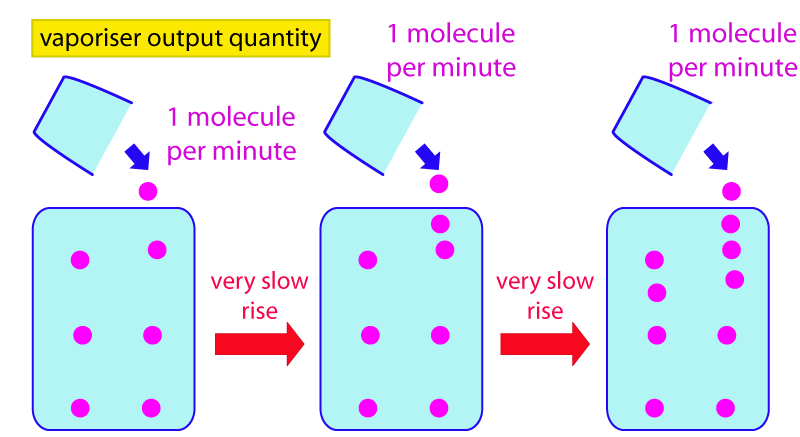
Here is the same thing said in “words”.

How to reduce the “rise time” :
The key to reducing the rise time is to increase the vaporiser output quantity. A larger vaporiser output quantity will fill the circle system quicker, reducing the rise time.

The vaporiser output quantity can be increased by increasing the vaporiser output concentration, or the fresh gas flow through the vaporiser , or both these at the same time. We will discuss these options next.
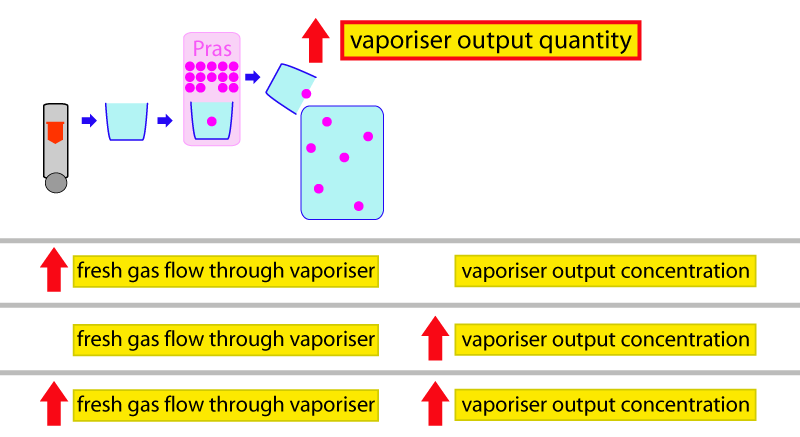
Increasing vaporiser output quantity :
Let us first take the option where you only increase the vaporiser output concentration while keeping a low fresh gas flow. While the cups come at a slow rate ( low fresh gas flow) , each cup is well filled. You can see that this increases the vaporiser output quantity, which will lead to a rise in the circle system concentration.

Another option is to only increase the fresh gas flow through the vaporiser. Though each “cup” gets only a small amount of anaesthetic agent, the large number of these cups coming out per minute increases the vaporiser output quantity.

The final option is to increase both, the fresh gas flow through the vaporiser and the vaporiser output concentration. Now the cups are well filled and you have many cups. This leads to the biggest increase in the vaporiser output quantity.

You have seen how you can increase the vaporiser output quantity by adjusting the fresh gas flow through the vaporiser and the vaporiser output concentration. However, with each of these, there are issues to consider. We will next discuss two of these issues : “fresh gas flow through vaporiser cost” and “vaporiser output concentration limit” .

Problem of high fresh gas flow through the vaporiser.
Using high fresh gas flows through the vaporiser is associated with a certain amount of wastage (cost). We will discuss this further.

To understand the high fresh gas flow cost issue, let us return to our patient friend in whom we want to quickly increase the inspired concentration. To rapidly fill the circle system, we increase the vaporiser output quantity by increasing the fresh gas flow through the vaporiser.
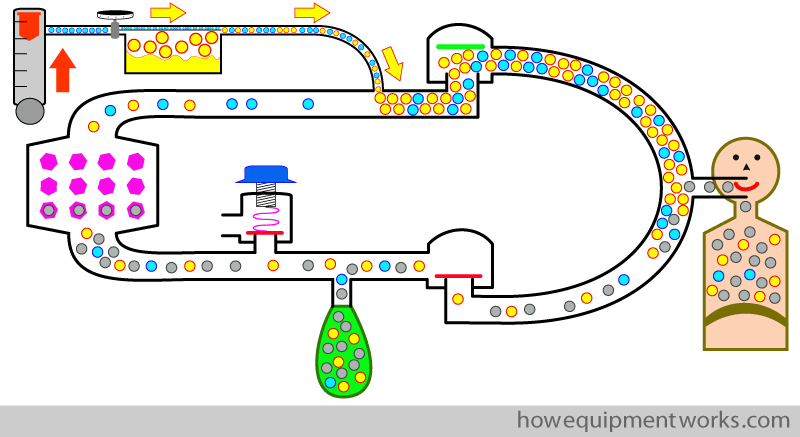
However, using high flows does have “economical” considerations. If you go back to the early part of our discussion of the circle system, you will remember that excess fresh gas flow is thrown out of the APL outflow valve (red arrow). This thrown out gas has anaesthetic agent which will be lost forever, which therefore, is considered to be “wasted”.

When high flows are used, there is more excess anaesthetic gases in the circle system. Therefore, more of it flows out of the APL outflow valve, leading to more “wastage”. You will remember that the the main attraction of the circle system is that of economy (i.e. not throwing things away). For this reason, at times when we use high fresh gas flows, we could say that the circle system is running “less economically “.

Vaporiser output concentration limit :
In the previous section, you saw that using high fresh gas flow through the vaporiser can lead to waste. So you might wonder, why not keep the fresh gas flow low and instead, just use a very high vaporiser output concentration to increase the vaporiser output quantity ?

The problem is that many vaporisers ( perhaps due to engineering problems or safety concerns) cannot increase the vaporiser output concentration beyond a certain amount. I.e. the vaporiser output concentration has an upper limit. This means that, at low fresh gas flows, your vaporiser output concentration limit may make it unable to deliver an adequate vaporiser output quantity needed to increase the circle system concentration sufficiently quickly.

For slow increases in circle system concentration, your vaporiser output concentration, even though it may be limited, may be adequate. However, if a quicker rise of circle system concentration is desired, you may have to also increase the fresh gas flow to compensate for the limited vaporiser output concentration. .

Let us summarise the salient points. To raise the inspired concentration, one needs to raise the circle system concentration. The circle system concentration depends on the anaesthetic quantity that is present in the circle system volume. We can increase the circle system quantity ( and therefore circle system concentration) by adding the vaporiser output quantity to it. The vaporiser output quantity depends on the fresh gas flow that you send through the vaporiser and the vaporiser output concentration that you set.

When we want to raise the patient inspired concentration, there is a delay between the time we set the vaporiser output concentration and the patient inspiring that concentration (rise time). This is because the vaporiser output quantity gets “diluted” into the large circle system volume.

The rise time can be shortened (i.e. made quicker) by increasing the vaporiser output quantity.

The vaporiser output quantity can be increased by increasing the fresh gas flow though the vaporiser and / or the vaporiser output concentration. At low fresh gas flows, the maximum vaporiser output concentration available from your vaporiser may be inadequate to sufficiently quickly increase the vaporiser output quantity. In that situation, you will have to increase the fresh gas flow as well. At times of high fresh gas flow, the circle system wastes some anaesthetic agent through the APL outflow valve and can be, at those times, to be considered to be running ” less economically “.

At this point, I have to make some apologies. The above concepts are straightforward once you understand them, but to explain them, I have resorted to using many imaginary things. To start with, in real life, the flesh gas flow does not come out in little cups ! Furthermore, Prasflurane has not yet been invented and vaporiser output concentration is NOT expressed in “molecules per cup” ! Finally the circle system is not a rectangular container. Please don’t mention these imaginary things when answering exams, as if you do, you will fail, and worse, they may refer you to mental health services. However, I hope these imaginary things have at least given you an introduction to the various issues surrounding the use of circle systems.

A little bit more about fresh gas flows and economy (cost) :
In our previous discussions, I have often mentioned that when high fresh gas flows are used, there is some wastage of anaesthetic gases out of the APL outflow valve.

However, it is extremely important to note that I am not saying that you should never use high fresh gas flows ! For an example, there will be times during your anaesthetic that you will want to increase the circle system concentration and deepen your patient. For slow increases, it may be enough to increase only the vaporiser output concentration, but if quicker increases are needed, you may have to use high fresh gas flows as well. In other words, while you may aim to use lower the fresh gas flows as much as possible, clinical needs will at times move you away from that aim.

What I am trying to say is that, at times, it is appropriate to use high fresh gas flows, even though at those times, the circle system runs less economically. You can’t always put economics first, like the guy below who uses his wife to save on buying a front wheel for his tractor !

For an example, one occasion that you have to use high fresh gas flows is during the start of an anesthetic. When you start your anaesthetic, the circle system is “empty “.

To fill the “empty” circle system, you need to initially use a high fresh gas flow to give a large vaporiser output quantity.

The need for high fresh gas flows at the start of an anaesthetic makes the circle less economic when used for short cases than when used for long cases. Let us imagine that you have two operating rooms using circle systems. In one, you are the anaesthetist, and there is only one all day anaesthetic ( green graph). At the start of this case, you would use high fresh gas flows to deepen the patient. Once the case was under way, you would reduce fresh gas flows. Now let us look at your colleague in the other operating room. She has six patients needing very brief anaesthetics ( pink graph). At the start of each anaesthetic, she will need to use high fresh gas flows. However, before she can lower the fresh gas flows significantly, it is time to wake the patient up ! So her fresh gas flow usage will be higher than your fresh gas flow usage. You can see in this example, how circle systems are more “economical” when used for long anaesthetics compared to when it is used for short anaesthetics.

Another small break for you !
Here is another illusion! Can you and your colleagues agree about which one of these circles is moving ? I made this illusion by modifying material made by a Japanese Professor of Psychology, Akiyoshi Kitaoka.

How low should we go ?
You are now aware that when we reduce the fresh gas flow, the amount of anaesthetic agent coming out of the APL out flow valve is reduced (i.e. less wastage). Now we can discus the question, How low should we go ?
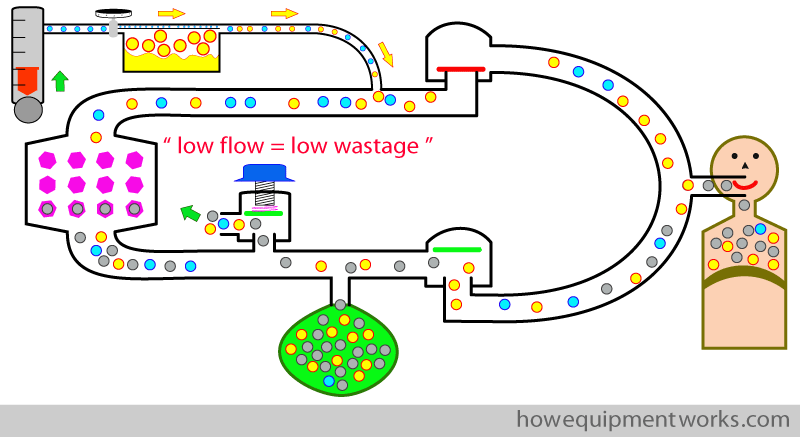
You can take the lowering of fresh gas flow to an extreme. The fresh gas flow can be reduced to a level where the supplied oxygen exactly matches the patient’s oxygen consumption. At this level, the patient consumes all of the oxygen you give ( blue arrows) and no oxygen therefore needs to come out of the APL outflow valve. I would like to call this the “absolute minimum fresh gas flow”.

As mentioned before, at the absolute minimum required fresh gas flow, no oxygen goes out of the APL outflow valve, as the patient is “taking in “ all the oxygen that you are giving (blue arrows). The carbon dioxide produced by the patient is absorbed by the CO2 absorber ( grey arrows). Since both gases are ” consumed “, nothing comes out of the APL outflow valve and it remains “closed” throughout the respiratory cycle. Using the circle system in this way is therefore described as using it “fully closed “.

If you reduce the fresh gas flow below the “absolute minimum fresh gas flow”, the patient will become hypoxic.

Above the absolute minimum fresh gas flow, there will be loss anaesthetic gases ( oxygen + anaesthetic agent) out of the APL outflow valve.

Now you might think, that since running the circle system at the absolute minimum required fresh gas flow is the most economical (i.e. no wastage), that everyone should use the circles system at such a flow.

Unfortunately, reducing flow rates towards the absolute minimum fresh gas flow rate is not without danger. In practice, there could be many factors that can affect the circle system concentrations including variability between patients, quality of the equipment (including monitoring) and of course your level of skill and attention to continuous detail. Let me explain it by imaging that we are flying an aeroplane !

The mountains below represent patient harm. In an ideal world, you would be able to fly in a complete straight line.

In practice, there could be many factors that can affect how well you can maintain the level flying of the aeroplane. Perhaps there are unpredictable winds, maybe you are not a very experienced pilot or maybe your airplane (equipment) has a few faults. All this may make your flight path somewhat erratic. However, as you are flying quite high, you are quite safe, and there is no harm.

However, if you chose to fly nearer to the ground, your “safety margin” is reduced.

The big danger of flying very near the ground is that even a small loss of control will result in harm.

The other option is to fly really high, far away from danger. However, flying unnecessarily high consumes a lot of petrol and is wasteful.

So the ideal will be to choose an height that is not too low ( less safety margin) and not too high (wasteful).

Just like the airplane, the anaesthetic gas and oxygen concentrations in the circle system also can vary. The lower the fresh gas flow, the lower is the margin of safety. On the other hand, unnecessarily high fresh gas flows waste anaesthetic agent. The ideal would be to choose a fresh gas flow that is the lowest that you, in your circumstances, can safely use. i.e. not being wasteful and also not being unsafe. Now some of you will be expecting me to give a magic number that you should use. The answer is that I can’t. The fresh gas flows you choose will depend on your local circumstances such as training, equipment, etc.

Please don’ t think that I am against low fresh gas flows. With adequate experience, continuous vigilance, adequate monitoring and good quality equipment, you can safely use low fresh gas flows. What I would like to stress is that there is much more to ” low flow anaesthesia ” than simply turning the fresh gas flow control knobs down. Have a safe flight !

“Toxic “ gases:
At very low flows, as you know, very little or no gases flow out of the APL outflow valve. Therefore, any “contamination “ of the gases in the circle system will tend to stay there. For an example, the human gastro intestinal system can contain methane, which can diffuse into the circle system and remain there. This is a very specialist area which is beyond my expertise, so I will not discuss it further here.

The need for good monitoring :
As you probably realise now, the concentration of the gases in the circle system are determined by complex factors and therefore it can be difficult to be exactly certain about what is happening.
For an example, in real life, the patient does not take in anaesthetic agent in the simplistic manner I have shown so far.

In reality, the “rate” that the patient takes up the anaesthetic agent ( agent “uptake”), doesn’t happen in a constant way. Instead it is a bit like when someone hungry eats something nice. Take this big chocolate cake shown below ( 1 ) that I wish to eat now. I am very hungry so my first bite is very big ( 2 ). But, after having that big bite, I am a little less hungry, so my next bite is a bit smaller ( 3 ). Now I am even less hungry than before, so my next bite is even smaller ( 4 ). Now I am almost full, so my next bite is really small ( 5 ).

And finally, I am really full , and actually don’t want any more cake. Therefore, over time, I take no more bites.

The uptake of anaesthetic is similar. Initially, at the start of the anaesthetic, the patient doesn’t have any anaesthetic agent and therefore is “hungry “ for it “, so the rate of uptake is high.

But as the patient takes in more anaesthetic, the rate of uptake reduces.
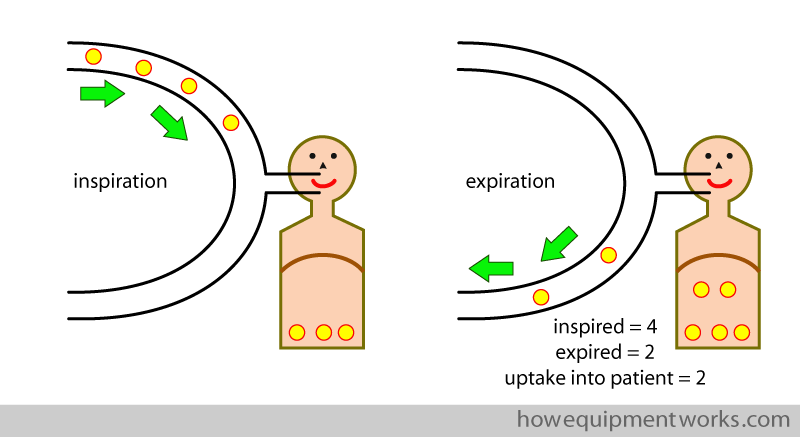
If the anaesthetic goes on for long enough, the patient may actually become “full”, needing no further anaesthetic uptake ( in practice, patient will always need some due to some of the anaesthetic being metabolised).

Therefore, as the anaesthetic progresses, one may need to reduce the vaporiser output quantity to reflect the decreased anaesthetic uptake. Of course, in reality, the patient isn’t really “hungry “ for anaesthetic ! For the true explanation, you will have to refer to the pharmacokinetics of inhalational agents in pharmacological texts.
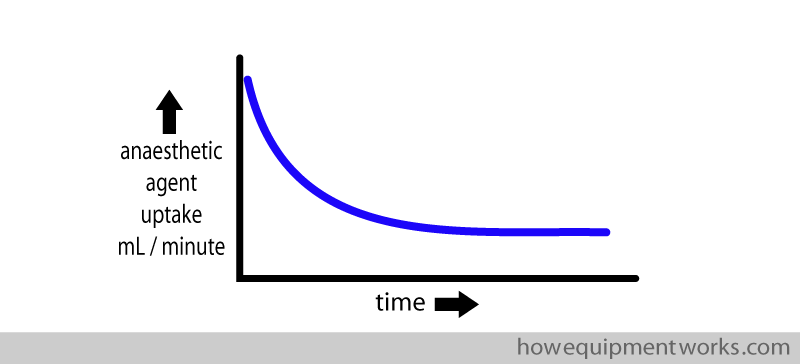
At this point I must stress that, to use the circle system safely, it is extremely important to have adequate gas concentration monitoring. As you have seen already, the circle system gases are affected by a number of factors. For an example, you saw how the rate of anaesthetic uptake by the patient changes over time. Furthermore, this rate of uptake may be different in different patients. Similarly, different patients may consume different amounts of oxygen. In addition, there all those other things we talked about, such as the factors that determine vaporiser output quantity etc. Many of these changes may be difficult to predict with complete accuracy, so it is absolutely mandatory that you have appropriate monitors that can measure circle system gases ( e.g. anaesthetic agent, oxygen, carbon dioxide etc).

Of course having good monitoring alone is not enough. You have to regularly look at your monitors and react appropriately !
Washing out :
We have previously discussed how to increase the circle system anaesthetic agent concentration. However, now it’s time to end your anaesthetic and wake the patient up ! You will recall that with circle systems, there is a delay (rise time) between you setting your vaporiser output concentration and the patient inspiring that concentration.
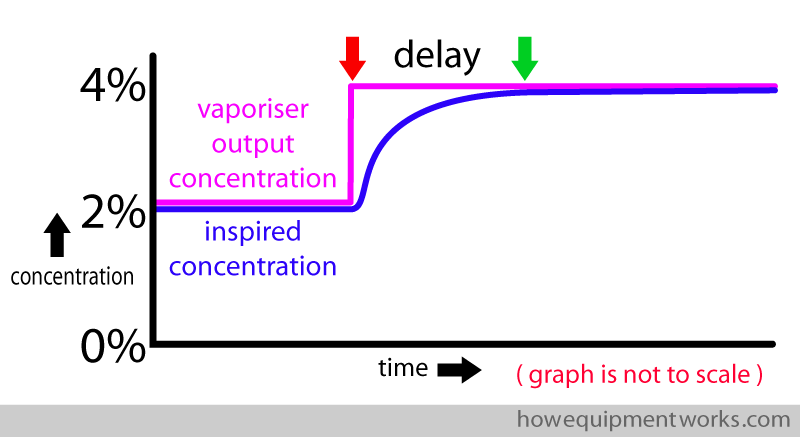
Unfortunately there is a similar concept when reducing your vaporiser output concentration to a lower setting or even zero ( switching it off ). There is a delay between the time you lower the vaporiser output concentration and the patient inspiring that lower concentration. I would like to call this, the “fall time”. We will now discuss how we reduce the circle system anaesthetic concentration and talk a little about the “fall time”.
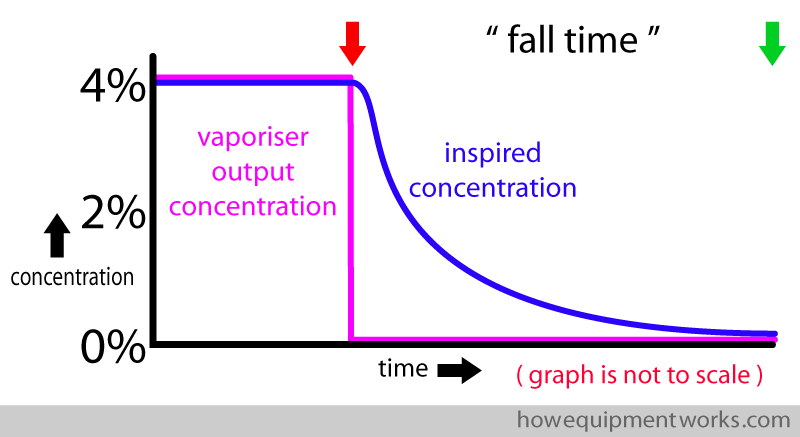
So how do we reduce the circle system concentration ( and therefore, the inspired concentration) ? To understand this, we return to the diagrams we used before. The circle system volume is represented by a container, into which the vaporiser output quantity goes into.

You will recall that during the use of the circle system, there is loss of excess gases, and along with it, anaesthetic agent, through the APL outflow valve.

I have attached the APL outflow valve to the container representing circle system volume. You can see that there are things going into the circle system and that there are things going out of the circle system.

The volume in the circle system is fixed. Therefore, whatever volume that is given into the circle system has to come out of the APL outflow valve. i.e. the fresh gas flow that you give into the circle system equals the flow of gases going out of the APL outflow valve.

The anaesthetic agent concentration in the fresh gas flow going into the circle system depends on the the vaporiser output concentration that you set.
The anaesthetic agent concentration in the gases going out of the APL outflow valve depends on the anaesthetic agent concentration in the circle system.

Now its time to wake up your patient ( at last !) and therefore you turn off the vaporiser ( i.e. vaporiser output concentration = zero). You can see that the anaesthetic agent concentration in the fresh gas flow going into the circle system ( i.e. zero) is less than the anaesthetic agent concentration in the gases going out of the circle system ( APL output concentration) . Therefore, there is an overall loss of anaesthetic agent out of the circle system.

As more fresh gas flow with no anaesthetic agent enters the circle system, anaesthetic agent from the circle system keeps getting thrown out of the APL outflow valve. Therefore the circle system quantity of anaesthetic agent decreases. The decreased anaesthetic agent quantity now spreads out in the circle system ( i.e. less tightly packed) and therefore the circle system concentration drops.
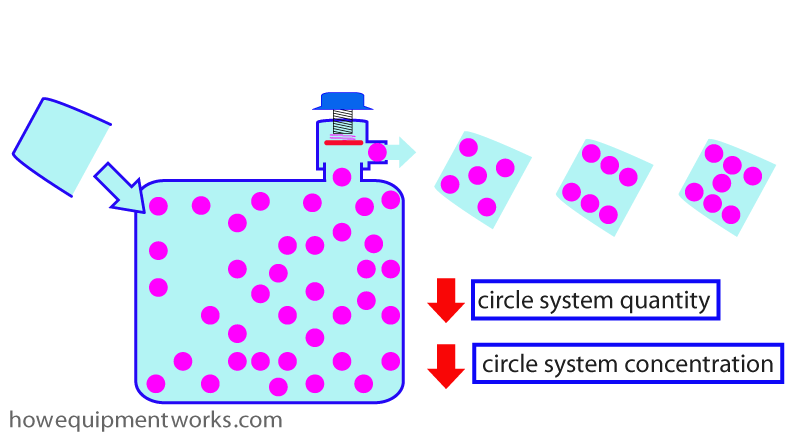
As the process continues, the circle system concentration keeps dropping.

Below is an image showing some coffee in a cup that is being washed away by a flow of water. This is quite similar to the way the circle system gets rid of the anaesthetic agent. You can think of the water as the fresh gas flow and the cup as the circle system. The coffee of course would be the anaesthetic agent.

Just like the coffee cup, in circle systems, the getting rid of anaesthetic agent is often called, “washing out of anaesthetic agent”.

The higher the fresh gas flow we use, the quicker will be the decrease in the circle system concentration. i.e. higher fresh gas flow leads to a quicker washout of anaesthetic agent.

This washing out process is why there is a delay ( “fall time”) between you switching off your vaporiser and the inspired concentration dropping to a point where the patient wakes up.
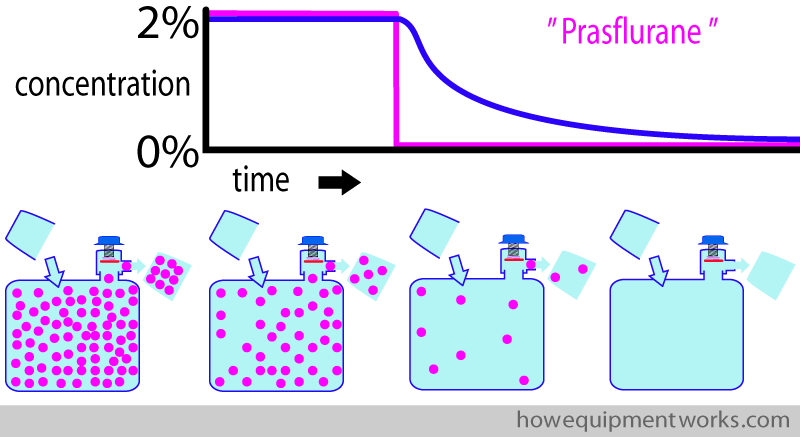
I have described many concepts in this web page in a simplified way ( I hope !) and I have used quite a few imaginary things ! Please refer to proper pharmacology resources etc. to get a deeper understanding of things. For example, in real life, the “wash out” curves of anaesthetic agents in circle systems are “exponential”. Such curves can be described in terms of half life and time constants.

We have come to the end of our discussion introducing you to some of the concepts involving circle systems. I found it quite challenging to explain the concepts and am not sure if my explanations make sense. I would be really grateful if you will give me feedback by clicking the feedback button on the menu at the top. Thank you !

